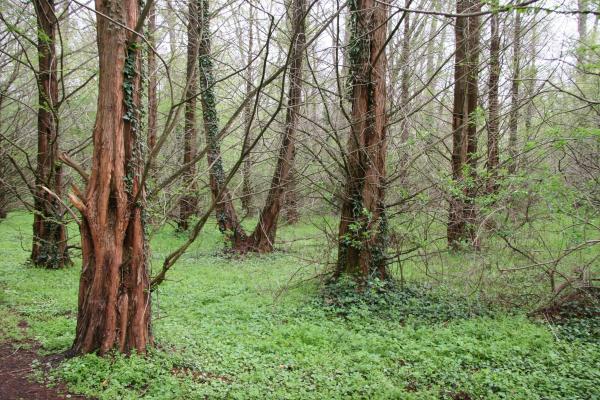
8380 Hévíz, Dr. Schulhof Vilmos street 1. Tel.: +36 83 501 700, Fax: +36 83 540 144


Geobotanically the western park forest belongs to the Saladiense of the Pannonicum.
The composition of the trees does not comply with the natural forest type which would be adequate to the local climatic and soil conditions. The natural forest would be an Illyrian type hornbeam forest (Helleboro odoro-Carpinetum) (Code K4). On the shrub and grass stratum of the forest typical species of this plant community can be found, i.e. European privet (Ligustrum vulgare), European spindle (Euonymus europaeus), common dogwood (Cornus sanguinea), bear's garlic (Allium ursinum), snowdrop (Galantus nivalis) etc. In fact the upper foliage stratum consists of Austrian pine (Pinus nigra), Norway spruce (Picea abies), European larch (Larix decidua) clusters of trees. The lower folliage stratum is dominated by the black locust (Robinia pseudo-acacia), tree of heaven (Ailanthus altissima), maple ash (Acer negundo), sycamor maple (Acer pseudo-platanus) and Norway maple (Acer platanoides). On the grass stratum of the forest there are aboundant Ivy (Hedera helix), wood bluegrass (Poa nemoralis), sweet violet (Viola odorata), lesser periwinkle (Vinca minor). The 100 year-old or older hornbeam specimens recall the past, while the trunk forms of the hornbeam (Carpinus betulus) bear witness of the former meadow cultivation.
The bogy basin of Hévíz geobotanically belongs to the Saladiense of the Praeillyricum of the Pannonicum.
The lake of Hévíz and the sorrounding marshy and boggy area show an organic hydrogeological, ecological and geobotanic unit. The human intervention already dominate the original natural components.
In the lake and the draining canal there are numerous original watery, boggy and marshy species (Butomus umbellatus, Carex ellata, C. oederi, C. paniculata, C. pseudocyperus, Cirsium oleraceum, C. palustre, C. rivulare, Eriophorum angustifolium, Filipendula ulmaria, Galium uliginosum, Hydrocotyle vulgaris, Lathyrus palustris, Nymphaea alba, Peucedanum palustre, Potentilla erecta, Salix cinerea, Scyrpus silvaticus, Schoenus nigricans, Taraxacum palustre, Thelipteris palustris, Triglochin palustre, Veronica scardia). The presence of several weed species is also conspicuous (Carex hirta, Chelidonium maius, Galium aparine, Sambucus ebulus, Urtica dioica).
The most famous wild species of the lake is the bulrush as a warm age relict (Schoenoplectus litorális).
The bog used to spread from Dobogó to the villages of Komárváros and Csákány. On the accumulated thick truf layer reed grassy areas (Myriophyllo-Potametum, Hydrochari-Stratiotetum) reedy areas (Scirpo-Phragmitetum), marshy meadows (with Agrostetum albae, and with Alopecuretum pratensis), rushy areas and boggy meadows (fen and flush vegetation - Schoenetum nigricantis, Juncetum subnodulosi), Salicetum cinereae, and gallery forests of shrub willow were formed. The forrunner of the northern and eastern protective forests were the soft-wood grove-forest (Salici-populetum) (Code J4). Here and there ash grove-forests (Cariceto Remotae-Fraxinetum) (Code: J4) then ash-alder grove-forests (Fraxineto pannonicae Alnetum) (Code: J2) were formed. The ash must have been a Hungarian sub-species of the angustifoliate ash (Fraxinus angustifolia ssp. pannonica). This area still belongs to the forest type of a plain semi-wet soft-wooded gorve-forest, bog forsest with alder (Dryopteridy-Alnetum) (Code: J2). Its natural mix-tree is the Hungarian ash (Fraxinus angustifolia ssp. pannonica). Its typical indicator plant is the lesser pond sedge (Carex acutiformis).
The natural forest communities were replaced by artificial forests - a process started in the 1910s. A well inlaid by smooth stones in the eastern protective forest and a drinking trough reflect former meadow cultivation. At the end of the 1950s poplar (Populus alba) was planted followed by a common alder stock (Alnus glutinosa) after its celaring in 1992 . The alder was mixed with Hungarian ash (Fraxinus angustifolia ssp. pannonica), domestic poplar and willow species. At the shrub stratum the miller (Padus avium) and the elderberry (Sambucus nigra) create communities. At the semi-wet places of the grass stratum giant soldenrod (Solidago gigantea), wild hemp (Cannabis sativa), black nightshade (Solanum nigrum), fleabane (Erigeron canadensis), plantain (Plantago maior), mapleleaf goosefoot (Chenopodium hybridum), white goosefoot (Ch. album), marshpepper knotweed (Polygonum hydropiper), hemp nettle (Galeopsis speciosa), tansy (Tanacetum vulgare), while at wet spaces water mint (Mentha aquatica) and tufted hairgrass (Deschampsia caespitosa) can be found. The ivy (Hedera helix) is widespread at both places. With the exception of the renewed stocks there are old, artificially planted and unmixed common alder (Alnus glutinosa) stocks in most parts of the area.
The cimatic effects together with the hydrogeologic conditions of the lake and its environs are the key factors influencing the nature of the plant stock of the park and at the same time they help to maintain a specific plant stock similar to the arboretums. This special condition is only partly utilised in the park especially through the water lillies of the lake and the plants of the tree stock with special needs (Metasequoia glyptostroboides, Taxodium distichum.
The park does not have any natural vegetation, so its significance can be seen in its old plant stock with rarities, its special conditions and history.